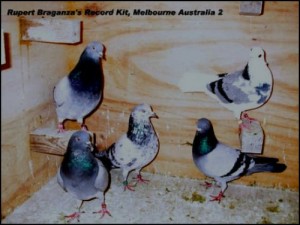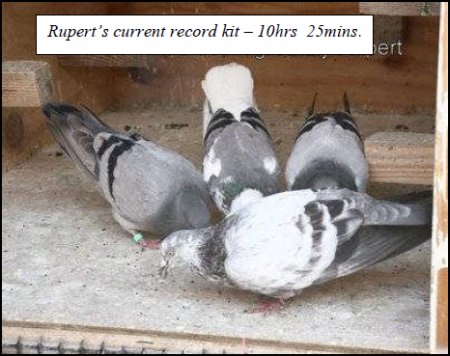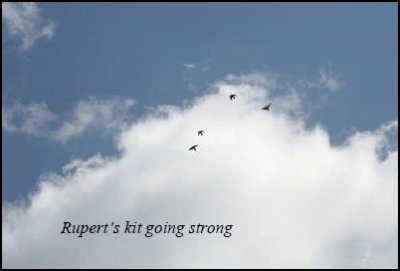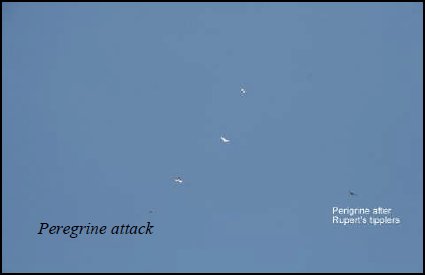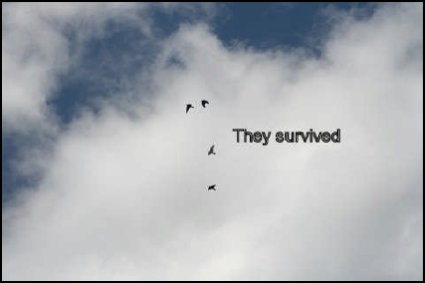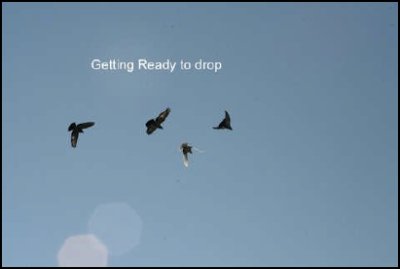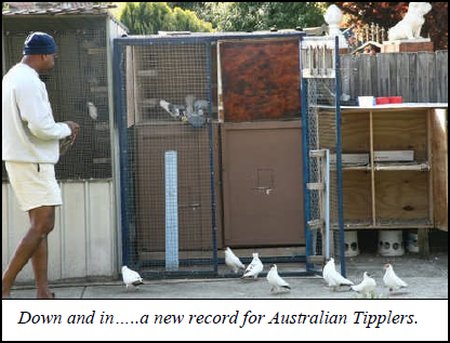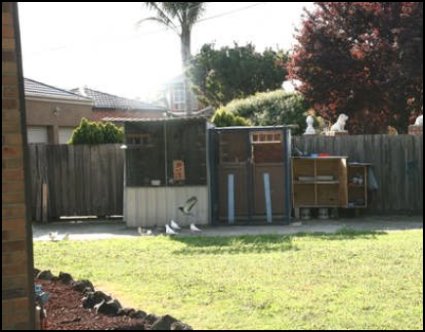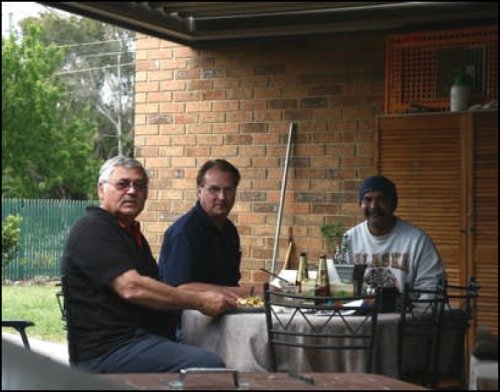by Danny McCarthy & Rupert Braganza (10 hours 25 minutes,
October 10, 2010)
Click on the PDF article below to open it in a new tab or window:
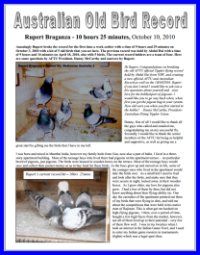
Amazingly Rupert broke the record for the first time a week earlier with a time of 9 hours and 29 minutes on October 3, 2010 with a kit of 5 old birds that you see here. The previous record was held by Abdul Hai with a time of 9 hours and 16 minutes on April 18, 2010, also with 5 birds. The current record holders are a team of four. Here are some questions by AFTU President, Danny McCarthy and answers by Rupert.
Hi Rupert, Congratulations on breaking the old AFTU official Tippler flying record held by Abdul Hai from NSW, and creating a new official AFTU and Australian Record as well on the 10/10/2010. Rupert if you don’t mind I would like to ask you a few questions about yourself and your love for the hobby/sport of pigeons. I would like you to go way back when, when first you got the pigeon bug in your system. How old were you when you first started in the hobby? Danny McCarthy, President- Australian Flying Tippler Union
Danny, first of all I would like to thank all the guys who called and emailed me, congratulating me on my successful fly. Secondly I would like to thank the senior members of the AFTU for being so helpful and supportive, as well as giving me a great start by gifting me the birds that I have in my loft.
I was born and raised in Mumbai India, however my family hails from Goa, now also a part of India. I lived in a threestory apartment building. Most of the teenage boys who lived there had pigeons on the apartment terrace – no particular breed of pigeons, just pigeons. The birds were housed in wooden boxes on the terrace. Most of the teenage boys would save and collect their pocket money so as to buy food for these birds. As the boys grew up and moved on in life, some of the younger ones who lived in the apartment would take the birds over. As a small kid I used to feed and look after the birds, and make sure that they were secure at night, locked away in their wooden boxes. As I grew older, my love for pigeons also grew. I had a few of them by then, but did not know anything about their flying ability etc. One day the caretaker of the apartment pointed out three of my birds that were flying in dots, and told me about the competitions that were held in his native state of Rajistan. This is what got me hooked on high-flying pigeons. I then, over a period of time, bought a few high flyers from the market, however, not all of them lived up to their potential – very few of them flew well. I was in my twenties when I took an interest in the Indian Game Fowl, and I used to enter my Indian game roosters in tournaments (fights) which was a legal sport then.
On one of my visits to the cock fight arena, one of the guys whose bird was supposed to fight my bird the following Sunday, requested a postponement to the fight date, as he was flying his pigeons in competition on that date and had a personal bet riding on it. I asked him if I could visit his home to watch the birds fly: he kindly agreed. The next Sunday I was at his place before sunrise and observed the referee noting the colours of the birds and stamping their tails. 21 pigeons were released that morning with 2 referees and 4 other onlookers present. As the day continued, more and more fanciers came to watch the fly, and some of them explained how the tournaments are organized. Tournaments are usually held on three Sundays during the month of December: the flyer must release a minimum of 17 birds which are required to fly for 6 continuous hours in order to qualify: any bird landing before the 6 hour mark is disqualified. For those birds landing after 6 or more hours, an aggregate time is taken, and the flyer who has the highest aggregate time is declared the winner.
Now that I had witnessed an official comp fly, I got the pigeon bug again. A couple of months later I found myself with a friend on a train making our way down to Lucknow in the North of India. I was told at the time that Lucknow was the head quarters for highflying pigeons. Once I arrived at Lucknow, I contacted some local breeders and bought 10 pairs of breeders and 30 young ones for flying. It was in December 1988 that I participated in my first competition fly. From then on until 2002 I flew every year – in both the summer and winter competitions: and included the local and “All India Competitions. I was lucky enough to win many prizes.
In 1992 I was introduced to the Rastriya Pigeon Flying Club, which organized the All India Summer competition. At that time no one in Mumbai had ever flown in the All India Competition, so I got a few guys together and flew in the All India Comp. I was lucky enough to win a consolation prize. The prize distribution for that comp was held in Jabalpore in Central India, where I met many pigeon fanciers from all over India. It is here that I came to know about the ALL Indian Pigeon Flying Club, which was a much bigger club than the Rastriya Pigeon Club. This club organized all the winter tournaments, which were held in the month of November. The following year I went to the prize distribution of the All Indian Pigeon Flying Club, which was held in Rampur at the farm house of Mr. Dalbir Singh Sandhu. Mr. Sandhu asked me how the sport of pigeon flying was progressing in Mumbai. He also asked if I would consider becoming a member of the committee, and handle the affairs of the Maharastra region of the pigeon club. I agreed to do so, and became a member of the Executive Committee.
I have contemplated giving up the hobby of pigeon flying on two occasions. The first was when I got married, however I could not part with my birds regardless of all my intentions to do so. The birds never left the terrace. The second time was when I immigrated to Australia and arrived in Melbourne on 30 June 2002. However, after leaving India I did not get rid of my birds in Mumbai, but was fortunate to have a good friend look after them for me. My passion for the sport was far too strong to get rid of my birds, and as such I went back to Mumbai in November of the same year and flew my birds in four winter comps. However, on this occasion, before I left Mumbai for Melbourne in January 2003, and as the family home had been sold, I was compelled to give my birds away to friends before returning to Australia. When I returned to Melbourne I had no intention of keeping pigeons. However I joined the Tippler Talk forum and enjoyed reading the comments that were posted on this site. Until this time I had not read any books on pigeons – on how to bred and fly them. Everything I know about the sport of pigeon flying and breeding I learnt from the fanciers in India who have been in the sport for years, and in turn have gathered the knowledge from their fathers and grandfathers who have been steeped in the sport for generations. I learnt a lot from these fanciers about things such as the configuration and value of seeds: when to feed such seeds to the birds, i.e. during their molt, what to feed when flying etc etc. One such person is Mr. Dalbir Singh Sandhu from Rampur the sole creator of the All India Pigeon Flying Club, who has successfully run it for 40 years. In India most of the feed ups consist of almonds and some other dried fruits mixed with some herbs and roots, which are found locally. The dried fruits give the birds the stamina required for them to perform in the air, and the herbs and roots act as a purgative, to remove the excessive feed that is sometimes given to the birds and in addition, relieves any ailments that the birds may be suffering from (i.e. aches & pains).
When you did finally decide to stay in Australia, what got you back into pigeons? Why Tipplers?
I came to Melbourne Australia on the 30 June 2002. After a couple of years I could not resist the craving to keep pigeons again, the passion was too strong. My first port of call was a local racing pigeon club. I soon found out that if I wanted to compete. I would have to have at least a hundred birds in my loft. As I was renting my premises at the time this was not possible. I then visited various high flying pigeon Clubs, and realized that nobody competed. A couple of guys tried to sell me birds for $100.00 each, but when I asked them to fly the birds for me, as I would like to see them fly before I bought them, they were not willing to do so. At the local market I met a Guy by the name of Bogdan Vasil. Bogdan had Serbian highfliers and Budapest highfliers. He invited me to his home and opened his loft to me and asked me to take whatever I wanted from his loft. When I told him I was into endurance flying, he offered me the last two pairs of tipplers he had in his loft. He told me both pairs were from a man known as Jack fromWangaratta. I took the blue bars that he offered me, and that is what got me started. Needless to say Bogdan and I have become very close friends.
Why did you join the AFTU?
A guy from India who was on Tippler Talk at the time informed Paul Windler who was the then Secretary of the AFTU about me. Paul called me up and chatted with me about pigeons, and told me about the AFTU. I then got a call from you (Danny McCarthy) and you introduced me to the rest of the members of the AFTU. From the word go, I hit it off with the guys from the AFTU, as they were all down to earth guys. A few months later Danny bred me 10 youngsters to fly. As soon as I received them I knew they were good birds. I homed all of them, but lost four of them to the falcons while training them. I then decided to stock the rest. Since our first telephone conversation, Danny and I have become very close friends: I only have to mention that I would like a certain strain of tippler, and it would be on the next flight to me from Danny’s loft. As a matter of fact my wife and I consider Danny and Pat as our own family. At present I am flying the Potts and Shannon strains of tipplers. I have also flown the Dunseith strain of tippler, and I love their flying style, however they seem to attract the falcons a lot. I am yet to try the Hughes strain of tipplers that Danny has sent me which are quite a few of them, all bred from his Hughes imports from the UK. At present I am breeding from them, and hope to fly the young ones shortly.
Do you have any secrets to your feed-ups? Only joking. I am sure many in the tippler sport here in Australia would like to know how you get the best out of your birds in the air.
Regarding my feed ups I am still in a trial and error mode and cannot say for sure if I have hit upon the perfect feed-up. However, one things for sure – I never use barley to train my birds. I did try it at one stage and found I lost a lot of birds. It does not give them enough strength to return back to the loft if and when they drift away, or they go so light they go into the pins and disappear. In training I work my birds to the maximum and do not stop even if they are being attacked by the falcon. I use the natural method for training my young ones. When they are just about covered with feathers I put them out and then walk them into the loft. Then introduce them to the top of the loft. This is done everyday even if it means for 5 minutes no matter what the weather, and the droppers are always with them. Within 10 days you will find the young ones going on to the loft roof and coming down on their own. The droppers are starved but not the young ones, this is just in case one of them takes off and gets lost he has enough in him for a couple of days to find its way back. When the young are 5 weeks old I start feeding them only wheat and reduce the feed. I throw one bird up at a time with the droppers out and until that one drops to the droppers regularly when signaled to do so, I will not let another one out. That is because no matter how hungry they are if they get company they get into the fly mode, and you will run into trouble, as the two young will just keep flying, because they have company. Once you have one of them trained to the droppers, and it is doing all the right things, I then let out the second one, then the third one and so on. My wife Rorine is a big asset to me: she does everything from feeding, flying and dropping the birds. The only thing she won’t do is clean the loft or handle the birds. She is a great help to me on days that I can’t release the birds due to work commitments as she does the needful, as well as drops them for me in the evenings when I can’t make it back home on time to do so myself. There are days when I lose birds in the evening due to the fact that my birds are not dark trained. If and when they return the next morning when I am at work Rupert’s kit going strong Peregrine attack and are flying over the loft, if my wife spots them, she will release the droppers, and make sure the birds are down and trapped before she leaves for work.
Last but not least, how do you fit both your sport of tipplers and your family into the equation, with such limited time that all of us have during a long working day?
Danny I don’t have a problem with that equation. My family will always come before my pigeons. It’s a no contest situation, and that’s the way it will always be.In closing I would like to say that it takes a lot of time and dedication along with a fair bit of patience to get these little flying machines to do the times we want them to do, and it takes just as much time, dedication and patience to get them to drop to your command. There are no short cuts, one has to put in the time if one wants the results.
Thank you Rupert for being so kind and answering all my questions. I wish you the very best of luck with your birds and hope you break some more records. Danny McCarthy.
This email below is from Darryl Sinclair (timer) advising other members of AFTU of the new record by Rupert.
Good evening all AFTU members today Sunday the 10/10/2010 I witnessed Rupert’s record flight in Australia. Arrived 6.00am took photos and verified the 4 birds to compete in today’s fly the weather conditions on release at 6.30am was misty and not very clear the birds started to kit and move with a fast motion. Approx. 10.00am the misty conditions started to clear to a blue sky. The birds flew low to medium height for most of the time at this stage but always in a tight kit beautiful to watch. Mid afternoon Robert Verbeek arrived to watch a falcon strike but the birds won for a change? and regroup within a few minutes and got back into there routine, about 4.00pm the birds then lifted to pin height and stayed there for 1/2hr. The birds started to show signs of coming down near the 10hr-15min mark then Rupert put the droppers out at 5.55pm 3 birds dropped and the last one dropped 5.57pm. I take this opportunity to thank Rupert’s lovely wife for all the great food and drinks that just never stopped coming all day, and to Rupert for making a new Aust. Tippler record. All photos and relevant paper work will be forwarded to this site soon as my computer won’t do it tonight. Cheers to All. Darryl Sinclair. Down and in…..a new record for Australian Tipplers.

